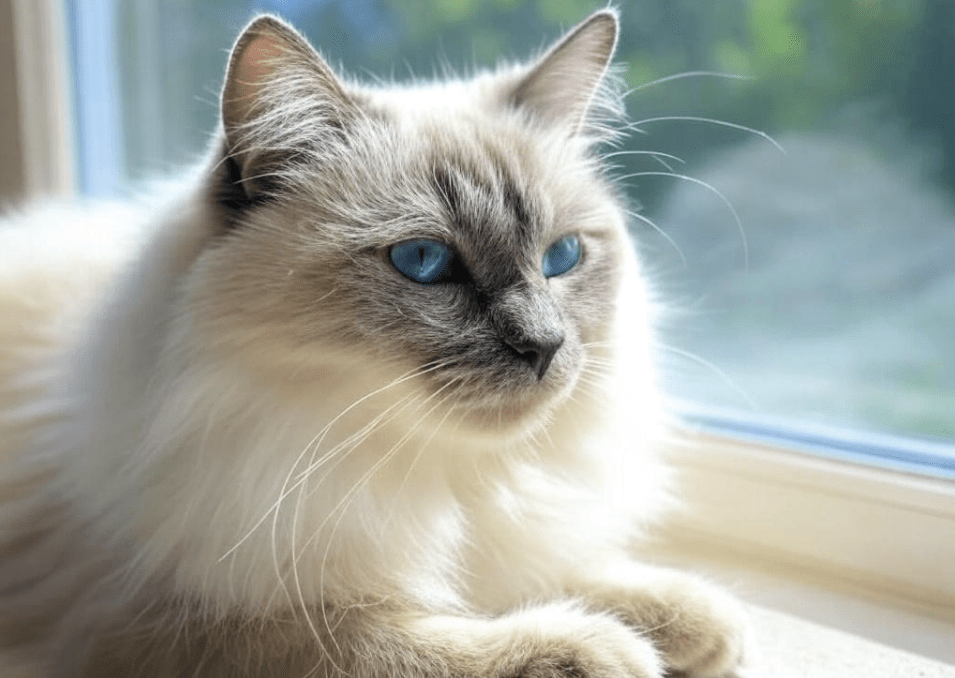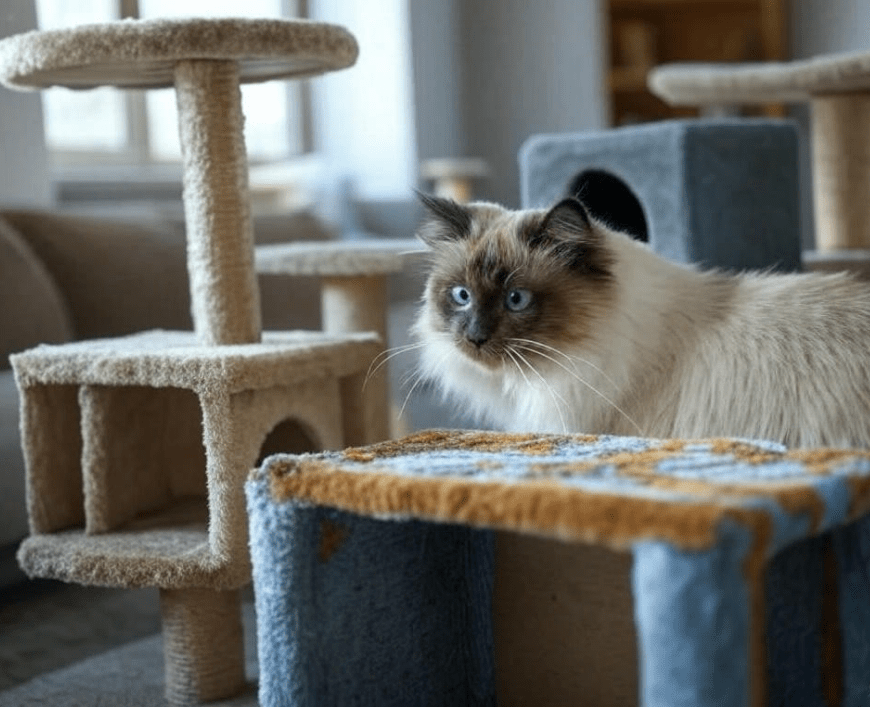
Learning how to clean your Ragdoll cat’s ears is an essential part of keeping your feline friend healthy and comfortable. Ragdolls, with their striking blue eyes and plush coats, are known for their gentle temperament, but their ears require regular care to prevent infections and discomfort. Improper cleaning techniques can stress your cat or cause pain, so it’s crucial to approach this task with care. In this comprehensive guide, we’ll walk you through the step-by-step process of cleaning your Ragdoll’s ears safely, share expert tips to avoid discomfort, and provide insights into maintaining optimal ear health.
Why Ear Cleaning Is Important for Ragdoll Cats
Ragdoll cats, like all felines, can accumulate dirt, wax, and debris in their ears, which may lead to infections or irritation if left unchecked. Regular ear cleaning is a preventive measure that promotes your cat’s overall well-being. Here’s why it matters:
1. Prevents Ear Infections
Ear infections, often caused by bacteria, yeast, or mites, are common in cats with unclean ears. Ragdolls, with their semi-long coats, may trap moisture or debris, creating a breeding ground for pathogens.
Signs of Infection: Redness, swelling, foul odor, or excessive scratching.
Risk Reduction: Routine cleaning removes wax and debris that could harbor bacteria.
2. Reduces Ear Mite Infestations
Ear mites are tiny parasites that thrive in dirty ears, causing intense itching and discomfort. Regular cleaning helps detect and prevent mite infestations early.
3. Enhances Comfort
A clean ear canal feels better for your Ragdoll, reducing irritation and the urge to scratch, which can lead to injuries or infections.
4. Supports Bonding
When done gently, ear cleaning can become a bonding experience, reinforcing trust between you and your Ragdoll.
Understanding Your Ragdoll’s Ear Anatomy
Before diving into how to clean your Ragdoll cat’s ears, it’s helpful to understand their ear structure. A cat’s ear consists of three main parts:
Outer Ear (Pinna): The visible, floppy part that collects sound. Ragdolls have soft, slightly rounded pinnae that are prone to collecting dust.
Ear Canal: A narrow tube that carries sound to the eardrum. This is where wax and debris accumulate.
Inner Ear: The sensitive area responsible for hearing and balance, which should never be touched during cleaning.
Knowing this anatomy ensures you clean only the outer ear and upper canal, avoiding damage to deeper, delicate structures.
How to Clean Your Ragdoll Cat’s Ears: Step-by-Step Guide

Cleaning your Ragdoll’s ears doesn’t have to be stressful for you or your cat. Follow these steps to ensure a safe and discomfort-free experience:
Step 1: Gather Your Supplies
Having the right tools is key to a smooth cleaning process. Use only cat-safe products to avoid irritation.
Veterinarian-Approved Ear Cleaner: Choose a gentle, non-alcoholic solution designed for cats. Avoid human ear cleaners or homemade remedies like vinegar, which can harm your Ragdoll.
Cotton Balls or Pads: These are soft and absorbent, perfect for wiping away debris. Avoid cotton swabs, as they can push debris deeper or damage the ear canal.
Towel or Blanket: Wrap your Ragdoll loosely to keep them calm and secure.
Treats: Reward your cat for cooperation, reinforcing positive associations with ear cleaning.
Gloves (Optional): If your cat has an infection, gloves can protect your hands.
Step 2: Create a Calm Environment
Ragdolls are sensitive to stress, so choose a quiet, familiar space for ear cleaning. Minimize distractions like loud noises or other pets.
Timing Matters: Clean your cat’s ears when they’re relaxed, such as after a nap or meal.
Comfort Your Cat: Speak softly and pet your Ragdoll to reassure them.
Step 3: Position Your Ragdoll Comfortably
Gently wrap your Ragdoll in a towel, leaving their head exposed, or hold them securely on your lap. Ensure they feel safe but not restrained.
Involve a Helper: If your cat is fidgety, ask someone to hold them gently while you clean.
Stay Relaxed: Your calm demeanor will help your Ragdoll feel at ease.
Step 4: Inspect the Ears
Before cleaning, examine your Ragdoll’s ears for signs of trouble, such as redness, swelling, or a foul odor. Healthy ears are pale pink, with minimal wax and no debris.
Look for Abnormalities: Dark, crumbly wax (a sign of ear mites), excessive wax, or pus may indicate a problem requiring veterinary attention.
Proceed with Caution: If you notice anything unusual, consult your vet before cleaning.
Step 5: Apply the Ear Cleaner
Follow the instructions on your veterinarian-approved ear cleaner. Typically, you’ll need to apply a few drops to the ear canal.
Gently Lift the Ear Flap: Hold the pinna to expose the ear canal.
Administer Drops: Squeeze the recommended amount of cleaner into the canal without inserting the bottle tip too deeply.
Massage the Base: Gently massage the base of the ear for 20–30 seconds to distribute the solution. You may hear a squishing sound, which is normal.
Step 6: Wipe Away Debris
Use a cotton ball or pad to gently wipe the inside of the ear flap and the upper ear canal. Be thorough but gentle to avoid causing discomfort.
Remove Visible Debris: Focus on wax, dirt, or loose debris. Never push the cotton ball too far into the canal.
Use Fresh Cotton: Switch to a clean cotton ball for each wipe to prevent spreading debris.
Step 7: Let Your Ragdoll Shake
After cleaning, allow your cat to shake their head. This helps dislodge any remaining debris or excess cleaner.
Protect Yourself: Step back to avoid getting cleaner on you, as Ragdolls may shake vigorously.
Wipe Again if Needed: Use a fresh cotton ball to remove any loosened debris.
Step 8: Reward Your Ragdoll
Immediately offer a treat or praise to create a positive association with ear cleaning. This makes future sessions easier.
Positive Reinforcement: A favorite treat or a short play session works wonders.
Monitor Behavior: Watch for signs of discomfort after cleaning, such as excessive scratching, and contact your vet if needed.
Step 9: Clean the Other Ear
Repeat the process for the other ear, using fresh cotton balls and a clean bottle tip to avoid cross-contamination.
Tips to Avoid Discomfort During Ear Cleaning

Ragdolls are known for their docile nature, but even they can become stressed if ear cleaning is uncomfortable. Here are expert tips to keep your cat relaxed:
1. Use the Right Products
Always choose a cat-specific ear cleaner with a neutral pH to avoid stinging or irritation. Avoid alcohol-based solutions, which can dry out the ear canal.
2. Warm the Cleaner
Cold ear cleaner can startle your Ragdoll. Warm the solution to room temperature by holding the bottle in your hands for a few minutes before use.
3. Be Gentle
Apply minimal pressure when wiping or massaging. Ragdolls have sensitive ears, and rough handling can cause pain or stress.
4. Keep Sessions Short
Aim for 5–10 minutes per cleaning session. If your cat becomes restless, take a break and try again later.
5. Watch for Stress Signals
Ragdolls may show discomfort through flattened ears, hissing, or trying to escape. If you notice these signs, pause and reassure your cat before continuing.
6. Clean Regularly but Not Excessively
Clean your Ragdoll’s ears every 1–2 weeks, depending on their wax buildup. Over-cleaning can irritate the ear canal and strip natural oils.
Common Mistakes to Avoid
To ensure a discomfort-free experience, steer clear of these common ear-cleaning errors:
1. Using Cotton Swabs
Cotton swabs can push debris deeper into the ear canal or damage the eardrum. Stick to cotton balls or pads.
2. Inserting Objects Too Deeply
Never insert anything, including your fingers or the bottle tip, deep into the ear canal. Stay in the outer ear and upper canal.
3. Ignoring Veterinary Advice
If your Ragdoll shows signs of infection or mites, don’t attempt to clean their ears without consulting a vet. Improper cleaning can worsen the problem.
4. Forcing the Process
If your cat is highly stressed, don’t force them to endure cleaning. Take a break and try again when they’re calmer.
5. Using Human Products
Human ear cleaners, hydrogen peroxide, or alcohol are harmful to cats and can cause severe irritation.
When to Consult a Veterinarian
While regular ear cleaning is safe for healthy Ragdolls, some situations require professional attention. Contact your vet if you notice:
Persistent Scratching or Head Shaking: This could indicate an infection, mites, or allergies.
Foul Odor or Discharge: A bad smell, pus, or dark wax may signal an underlying issue.
Redness or Swelling: Inflammation suggests irritation or infection.
Behavioral Changes: If your Ragdoll becomes lethargic or avoids ear contact, seek veterinary advice.
No Improvement After Cleaning: If symptoms persist after a few days of cleaning, a vet visit is necessary.
Your vet may prescribe medicated drops or perform a professional cleaning to address the issue.
Maintaining Your Ragdoll’s Ear Health
In addition to regular cleaning, these habits can keep your Ragdoll’s ears in top condition:
1. Monitor for Allergies
Allergies to food or environmental factors can cause ear inflammation. If your Ragdoll has frequent ear issues, discuss allergy testing with your vet.
2. Keep Ears Dry
Moisture in the ear canal can lead to infections. After baths, gently dry your Ragdoll’s ears with a soft cloth.
3. Regular Vet Checkups
Include ear inspections during annual vet visits to catch potential problems early.
4. Maintain Overall Health
A strong immune system helps your Ragdoll fight off infections. Provide a balanced diet, regular exercise, and a stress-free environment.
Why Ragdolls Need Special Ear Care
Ragdolls, with their semi-long fur and floppy ears, are more prone to trapping dust and debris than short-haired breeds. Their gentle nature also means they may not show obvious signs of discomfort until an issue becomes severe. By mastering how to clean your Ragdoll cat’s ears, you’re taking a proactive step toward their long-term health and happiness.
Conclusion

Knowing how to clean your Ragdoll cat’s ears without causing discomfort is a vital skill for any Ragdoll owner. By using the right tools, creating a calm environment, and following a gentle step-by-step process, you can keep your cat’s ears clean and healthy while strengthening your bond. Regular ear cleaning prevents infections, reduces discomfort, and ensures your Ragdoll remains the happy, affectionate companion they’re known to be.
With the tips and insights in this guide, you’re equipped to make ear cleaning a stress-free part of your Ragdoll’s grooming routine. For additional support, consult your veterinarian or connect with Ragdoll breed communities for breed-specific advice. Your Ragdoll will thank you with purrs and cuddles!




